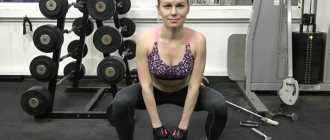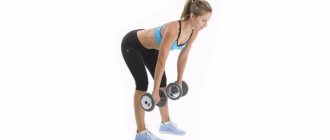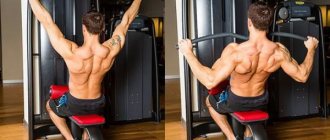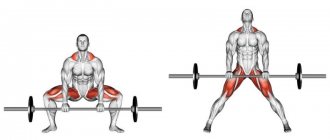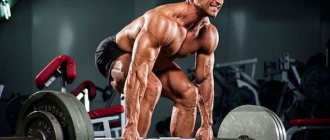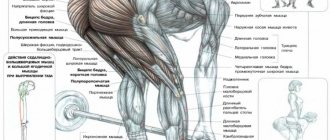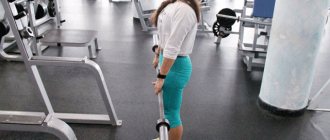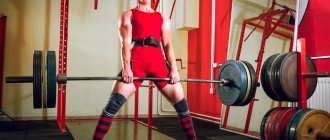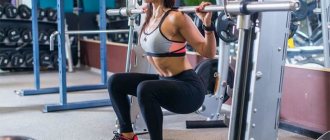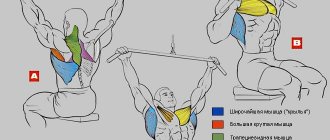The deadlift or dead lift is one of the varieties of the classic deadlift, which is so called because it is performed on straight legs, without bending the knees, literally tightly. This version of the deadlift is not a weightlifting exercise, but is widely used when building muscle mass in the gym, especially for women. This is due to the fact that deadlifts develop the gluteal muscles and hamstrings, the favorite muscles of the fairer sex, without involving the quadriceps. Next, we will consider the technique of performing deadlifts, Romanian and their main differences from the classical deadlift.
Where did these names come from?
First, let's look at the main differences between deadlifts and Romanian deadlifts. If the dead lift is performed with straight legs, then the Romanian deadlift is performed with the knees bent to about 15 degrees. The classic deadlift was the main exercise in weightlifting, and the Romanian deadlift appeared thanks to Romanian weightlifters practicing this technique. Judging by the fact that their athletes always stood out and took high places, the Romanian deadlift technique began to be used everywhere. Next, a variant of the Romanian deadlift appeared, which began to be performed with straight knees for greater stretching and involvement of the hamstrings in the work.
Essentially, the Romanian and deadlift are the same exercise, and the angle of knee flexion depends on the stretch of the hamstrings.
What is the difference between deadlift and Romanian
Both options involve bending the knees, but the difference between them is fundamental. In a classic deadlift, the movement is more similar to a squat, and the angle at the knees approaches 90 degrees. Deadlifts are performed mainly through the back, also involving the quadriceps of the thigh. In Romanian, the pelvis is primarily tilted and abducted, which is accompanied by slight bending of the knees, up to about 10-15 degrees. And the main muscles during the Romanian deadlift are the gluteal and lumbar extensors, without involving the quadriceps.
Difference between deadlift and deadlift
Two completely different movements. As already mentioned, the classic deadlift is performed with bending the knees, and the deadlift on straight legs, respectively, without bending the knees. If in the classical one the latissimus dorsi muscles, its extensors and quadriceps work to a greater extent, then in the dead one the hamstrings and gluteal muscles are subjected to great stretching, but the quadriceps do not work.
Main mistakes
- We are not doing a Romanian lift, so our legs are straight. Stretch to perform the exercise correctly and deeply. You can pre-train on a hyperextension machine. Try to make the deepest possible movements in it with a straight back. We find this to be a very effective preparation for stiff-legged deadlifts combined with stretching.
- Don't put your head down. Let's look ahead. It is advisable to stand in front of a mirror.
- When you take on a lot of weight, you begin to round your back. Because the weight is pulled not by the lower back, which lacks strength, but by the entire back. This is where all the injuries begin. It is enough to round your lower back and your entire back will follow suit.
- Shrugs should not be done together with deadlifts. Initially, fix your shoulders so that they are in a normal straightened position, and not raised up. We are pumping not the trapezius, but the lower back.
If the exercises are so similar, what should we do?
First of all, the bent leg deadlift is designed to increase mass and strength, and this is the base. The Romanian get-up (aka Romanian deadlift) and straight-legged deadlift are designed to work isolatedly on the buttocks and hamstrings, which is extremely important for girls. They don't put as much stress on the spine, but can lead to injury if you forget how to do the exercises correctly.
Before doing a classic deadlift, you need to work with simpler exercises to strengthen your back. And before them is a month of hyperextension and stretching.
So, when your stretching for some reason does not want to progress, you can stop at the Romanian deadlift. And if you can stretch enough, then do deadlifts with straight legs.
What to replace it with?
If it hurts to do deadlifts, then for the back of the thighs and lower back, try the following:
- Pulling your legs back with weights.
- Reverse hyperextension.
- Leg extension in the simulator.
- Leg press on the back of the thigh.
- Regular hyperextension.
Strengthen your lower back and leg muscles with these exercises, then try deadlifts. You can use an orthopedic belt if you have one. Or your doctor will prescribe it for you. A rigid athletic belt is not effective in this case.
The deadlift is part of the competitive disciplines at powerlifting championships, it is very much loved and respected by all bodybuilders and weightlifters, but no matter how much you now think that this is an exercise for big and strong men, we will debunk many myths about this.
The deadlift is a great exercise for developing the gluteal muscles, back and leg muscles, as well as the arms (although it’s better not to pull with your arms, but more on that later).
The deadlift, also known as the Romanian deadlift, is a lighter version of the classic deadlift. The difference between them is that with a deadlift, the barbell or dumbbells must be lowered to the middle of the shin, and not to the floor, as in the classic version.
Deadlifts with a barbell or dumbbells are a must-have exercise for girls who want to develop their gluteal muscles, as well as their biceps and triceps. Traction also helps to perfectly stretch the leg muscles. Don't forget that the calf muscles, back muscles and even the abs are also involved when deadlifting.
This is such a universal exercise for the whole body. Well, have the scary myths been dispelled a bit? Then let's continue further.
Dear girls, get rid of prejudices about pumped up giant muscles due to the increase in iron. For pronounced and emphasized all the convexities and concavities of the body, you just need to become close friends with deadlifts, dumbbells and barbells.
Girls also need traction, especially for beautiful buttocks.
The benefits and harms of deadlifts on straight legs
Thanks to the straight leg technique, the flexibility and elasticity of the muscles of the back surface of the body increases. This allows you to safely perform complex compound exercises that require a good stretch of these muscles, such as deep squats and other pulling exercises.
When the muscles of the posterior surface of the body are shortened, when they are in hypertonicity, hyperlordosis of the lumbar region, protrusion of the abdomen and forward displacement of the pelvis more often appear. Deadlifts allow you to stretch shortened muscles, return them to their normal physiological state and strengthen the stabilizers - the gluteal muscles, which are in an atonic state. Therefore, straight-legged deadlifts improve spinal health and posture.
If the muscles are too tight and experience pain when performing deadlifts on straight legs, you should replace the exercise with a safer one that does not stretch the hamstrings as much. Inelastic hamstrings - the biceps femoris, semitendinosus and semimembrane muscles are severely injured when stretched, and the technique leaves much to be desired, since it is impossible to perform the exercise with the required amplitude.
Therefore, the dead lift should be performed only if you have flexible and elastic muscle fibers.
Also, weak abdominal muscles do not allow the lower back to be fixed in a natural deflection, which causes it to become rounded. And when working with weights, there is a strong load on the vertebrae with further traumatization.
Maintaining the correct technique and position of the lower back in a natural deflection will prevent injuries and back pain.
conclusions
So, the Romanian deadlift is the most effective exercise for working the lower back, buttocks and hamstring muscles.
In order to achieve good results from training, you must:
- decide on your goals - to work your legs you need to use one version of the exercise, to work your back - another (but in general, a deadlift is better for the back);
- maintain a bend in the lower back when performing this exercise and do not use excessively heavy weights so as not to injure your back;
- keep your legs almost straight even when the barbell or dumbbells are lowered down - if you bend your legs at the knees, this will already be a deadlift;
- monitor the range of motion: it should be close to the maximum, at the lowest point the shoulders should be at the level of the buttocks or lower, and the back of the thighs and lower back should be stretched as much as possible, then the deadlift will bring a good effect.
- perform the exercise smoothly and without jerking, mentally concentrating on the work of the target muscles.
What muscles work
Main muscles:
- Spinal extensors.
- Large gluteal muscles.
- Biceps femoris muscles.
Stabilizing the spine also involves the rectus abdominis, trapezius, and forearms.
Technique for performing deadlifts with a barbell
- Place the barbell in the power rack at hip level, select a suitable load weight, do not take too much weight, as this will injure the hamstrings.
- Grasp the bar with an overhand grip, shoulder-width apart.
- Remove the bar, take a couple of steps back and place your feet hip-width apart, parallel to each other.
- Look in front of you, gather your shoulder blades and tighten your abdominal muscles.
- As you inhale, tilt your body forward while simultaneously moving your pelvis back without bending your knees. The body weight should shift to the heels.
- Your back should be in a slight arch; to do this, pull your tailbone back and tense your abs. Arms straight and relaxed.
- The forward tilt of the torso depends on the degree of muscle flexibility; it is enough to lower the bar, which runs straight along the hips, to approximately the middle of the shin.
- As you exhale, push off with your heels and straighten your straight back in reverse order using your gluteal muscles and lumbar extensors.
- At the top point, straighten up completely.
- Continue the movement for the required number of repetitions without experiencing any acute pain. At the end of the set, return the bar to the power rack.
Deadlift: anatomy of muscle work
As I said above, when performing a deadlift, a large number of muscles are involved in the work.
Namely:
- Gluteal muscles and hamstrings. These muscles tense in concentration! The main burden falls on them. This is a plus, because... The biceps of the thigh tend to lag behind in athletes.
- Rhomboids, trapezius, serratus.
- The core muscles (abs, spinal extensors) experience constant static tension during the exercise.
- Rotator muscles of the wrists, forearms, biceps and triceps of the arms, shoulders.
- The muscles are stabilizers of the lumbar region, which are responsible for keeping the back in a level position.
When performing a deadlift, most of the body is indirectly tensed, but you need to concentrate specifically on the gluteal muscles and the back of the thigh, therefore, in fact, you need to understand the technique of performing this exercise.
Romanian Deadlift Technique at Smith
The above technique can also be performed in Smith. Using an example, let's look at the Romanian deadlift with bent knees. The Smith machine makes it easier to perform deadlifts because the bar is mounted on guides, making it easier to control pelvic abduction and tilt.
- Place the bar on the clamps of the machine at hip level.
- Stand in the center of the bar and grab it from above, shoulder width apart. Turn the locks and remove the bar from the clamps.
- There is very little distance between the feet and the bar; the bar should slide along the shin. Place your feet parallel to the width of your pelvis.
- Look in front of you and, as you inhale, tilt your body, moving your pelvis back and at the same time bending your knees, but not too much; the exercise is performed as a tilt, not a squat.
- Bring the bar to its maximum point at the bottom, but do not round your back. The inclination depends on the degree of muscle stretching.
- Exhale and straighten your torso, knees and pelvis in the upper position.
- After completing the approach at the top point, rotate the bar and secure.
Preparing to perform deadlifts: auxiliary exercises
The deadlift is a difficult exercise: without the correct technique and sufficient physical preparation, it can lead to spinal injuries. Beginners who have just started training first need to master several auxiliary exercises:
- Bent-overs with a barbell while sitting . Take the barbell, place it comfortably on your shoulders and sit on a gymnastic bench (lengthwise, the bench should be between your legs). We perform from 8 to 12 bends, with a straight back. At the lowest point we lower the stomach between the thighs. This exercise will help stretch the back extensor muscles, preparing the athlete for further stress;
- Hyperextension . Extending your back on an incline Roman bench will help prepare your lower back for the stress of a deadlift.
Most often, beginners perform deadlifts by leaning forward heavily and overloading the lower back. This is due not only to incorrect technique, but also to insufficient mobility of the hip joint. To develop it, and at the same time improve your deadlift technique, exercises with kettlebells are perfect:
- We place our feet on both sides of the weight (optimally 16 kg) one and a half shoulder width apart, bend our back, bend our knees slightly and pull the weight with both straightened arms;
- Starting position “feet shoulder-width apart”, place 2 weights on each side of you, bend your back and, slightly bending your knees, lift the weights: this exercise clearly explains the principle of deadlift.
Deadlift technique in a crossover
Deadlifts and Romanian deadlifts are also performed in the lower block of the crossover. Of course, the barbell is the most preferred equipment, as it is a free weight. The lower block is not designed for vertical movement of the handle along the shin, so you have to move back; accordingly, the block pulls your arms forward and pulls the body behind it.
- Grab a straight handle shoulder-width apart while facing into a crossover.
- Take a few steps back while pulling on the cable.
- Place your feet hip-width apart, tighten your abs and keep your lower back in a natural arch throughout the entire approach.
- As you inhale, tilt your body forward, moving your pelvis back, transferring your center of gravity to your heels. Don't bend your knees. The arms are freely extended behind the block with the handle, but it is important to ensure that the weight does not pull the body forward and does not shift the load to the toes.
- As you exhale, straighten your torso, pushing off with your heels, and fully straighten all joints at the top point.
Barbell deadlift: features and technique
The classic version of the deadlift is aimed at working the lower back, trapezius muscles, hip stabilizers and buttocks.
The exercise is performed as follows:
- We stand close in front of the bar: feet approximately shoulder-width apart, shins in contact with the bar;
- We lean forward, keeping our back straight, and grab the bar with our hands. Your arms should be parallel to each other, at right angles to the bar: this will protect your hands from injury when lifting heavy weights. You can take the barbell with a different grip: one hand clings under the barbell, and the other on top of it. With this grip, it will be possible to perform a greater number of repetitions with greater weight: this technique can be used if the forearms and hands become very tired during the approach;
- We straighten up with the barbell in our hands, simultaneously straining our legs and back. The bar should slide closely over the body (at first, the athlete can seriously injure the front of the shins with the bar sliding over it: to avoid this, you can wear special leggings or tight pants);
- We perform 1-2 warm-up approaches with an empty bar. After this, use pancakes as additional weights.
Execution technique
If you still cannot master the correct technique for performing a classic deadlift, you can try a “partial deadlift.” Pulling from plinths (stands for a barbell) or two low benches will help relieve excess tension from the back that occurs during straightening.
An incomplete deadlift will promote the growth of lagging muscle groups: for tall athletes, this is sometimes the only way to finally feel the muscles of the back, and not the legs.
By adjusting the height of the plinths you can shift the load:
- If you pull the weight from a position “below the knees”, the erector spinae and quadriceps muscles will be involved in the work;
- If you pull the weight from a position “above the knees,” only your back will be involved in the work.
Sumo deadlift
The Sumo Deadlift is a classic powerlifting exercise designed to maximize the amount of weight lifted. The exercise is performed with a wide stance - approximately 2 shoulder widths.
Technique:
- We stand in front of the barbell, feet 2 shoulder-widths apart, toes spread to the sides. Keeping your back straight, bend your knees and grasp the barbell with both hands. Recommendations regarding grip are the same as for classic deadlifts;
- In one coordinated movement, we lift the weight, pushing the pelvis forward and quickly straightening up. While moving, we focus on the heels: they should be pressed into the floor (for this you need suitable shoes with flat, non-slip soles);
- At the top point we take a short pause and, moving the pelvis back, return to the first position.
Trap bar row
Equipment such as a “trap bar” or trap bar is quite rare in gyms; it looks like a large frame with weights hung on both sides. When performing deadlifts with a trap bar, the buttocks, hamstrings, and back (especially the extensor muscles) are involved.
Technique:
- We stand in the center of the projectile, lower our hips until they are parallel to the floor. We take hold of the handles;
- Holding the projectile in your hands, we gradually straighten our legs, returning to the starting position. The center of gravity must be shifted to the heels.
The advantage of this exercise is its ease of execution: it is often recommended for beginners. There is no need to look for a comfortable position for the barbell, in which it does not “scratch” your shins until they bleed. In addition, the arms are in a natural position, which allows you to perform more repetitions or increase working weights without the risk of injury.
The ideal geometry of movement in this exercise allows you to “hammer” the back muscles to failure: extensors, latissimus, major and round muscles.
Recommendations: how to perform deadlifts for girls and men
Both men and women are not recommended to perform deadlifts with maximum weights, since the biceps and ligaments already experience severe stretching; they should not be injured by working weights as in the classic deadlift. Think of the dead lift as an auxiliary exercise to tone your biceps and glutes. Perform it extremely carefully within 15-25 repetitions of 3 sets.
More trained representatives of the stronger sex can perform the exercise for 12-14 repetitions of 3-4 approaches. The exercise should only be performed after compound compound exercises that involve more muscles, such as barbell squats and leg presses.
If the exercise causes severe pain in the hamstrings, replace it with the Romanian deadlift, which will relieve the stretch.
Execution options
Deadlifts can be performed:
| With a barbell | An option that is the main one for many athletes. A deadlift with a barbell gives a good load to the back, but only if, when lowering the barbell, you move the bar along your legs without bringing it forward. So, first of all, the buttocks and hamstrings will work. |
| With dumbbells |
This option has an important advantage compared to barbell rows - the hands are located in a more natural position, so there is no unnecessary stress on the muscles and joints of the hands.
For some athletes, for example, those with hand injuries, this option is the only option. The advantage is that it puts a more serious load on the hamstrings and gluteal muscles.
In almost all gyms, this exercise is performed on two legs, but there is also an option to perform it on one leg: you need to take a barbell, lift one leg, bending it at the knee at an angle close to 90 degrees. While bending forward, move your raised leg back, straightening it at the knee to maintain balance. You can try doing it with weights - this will make it easier to retract your shoulder blades.
Grip options
There are three grip options when performing this exercise:
- Straight.
- Back.
- Multidirectional, or multi-grip.
The latter assumes that one hand is placed with a direct grip, and the other with a reverse grip. Which of these options to prefer is mostly a matter of taste. Every athlete has a favorite grip that is familiar to him.
You can do deadlifts by standing with your toes on two plates. This allows you to maximally load the gluteal muscles and hamstrings. Typically this option is used when performing deadlifts with dumbbells.
How to replace dead rods at home
At home, if you don’t have a barbell, you can perform the exercise with dumbbells, kettlebells, fitness bands and balls.
Deadlift with elastic band
Both a rubber band and an expander ring band are suitable for this exercise. It is necessary to step with your feet on the lower edge of the ring elastic or the middle of the tape, selecting a certain degree of tension, and grab the free edges. The stronger the stretch, the stronger the load. When you bend down, the band contracts, and when you straighten your torso, it creates the necessary resistance.
Deadlift with dumbbells
The technique remains the same; you need to hold dumbbells in both hands, placing them in front of your hips with your palms facing you.
Deadlift with kettlebell
The handle of the kettlebell must be held with both hands, taking the starting position, as in the deadlift with a barbell.
Read more about kettlebell deadlifts →
Deadlift with medicine ball
The medicine ball serves as a weight depending on its weight. To perform the exercise, hold the ball between your palms at your sides. Rowing with the ball occurs in the same way as with a barbell; the ball slides along the shin.
The best exercises with a medicine ball →
What equipment can you use for deadlifting?
Classic technique - using a barbell
However, to diversify your training, it is recommended to pay attention to other equipment. This will help shift the load angle slightly and give good results.
Today the most popular are:
- With a fingerboard. A classic option that is used in any strength sport.
- In Smith. It turns off the work of stabilizer muscles, suitable for beginners or those recovering from injuries. Suitable as an additional exercise, but it is better to work with free weights.
- Weight. Due to the shift in amplitude, more load is placed on the middle of the back and forearms.
- With dumbbells. Similar to a kettlebell, the load moves closer to the center and also engages the forearms.
